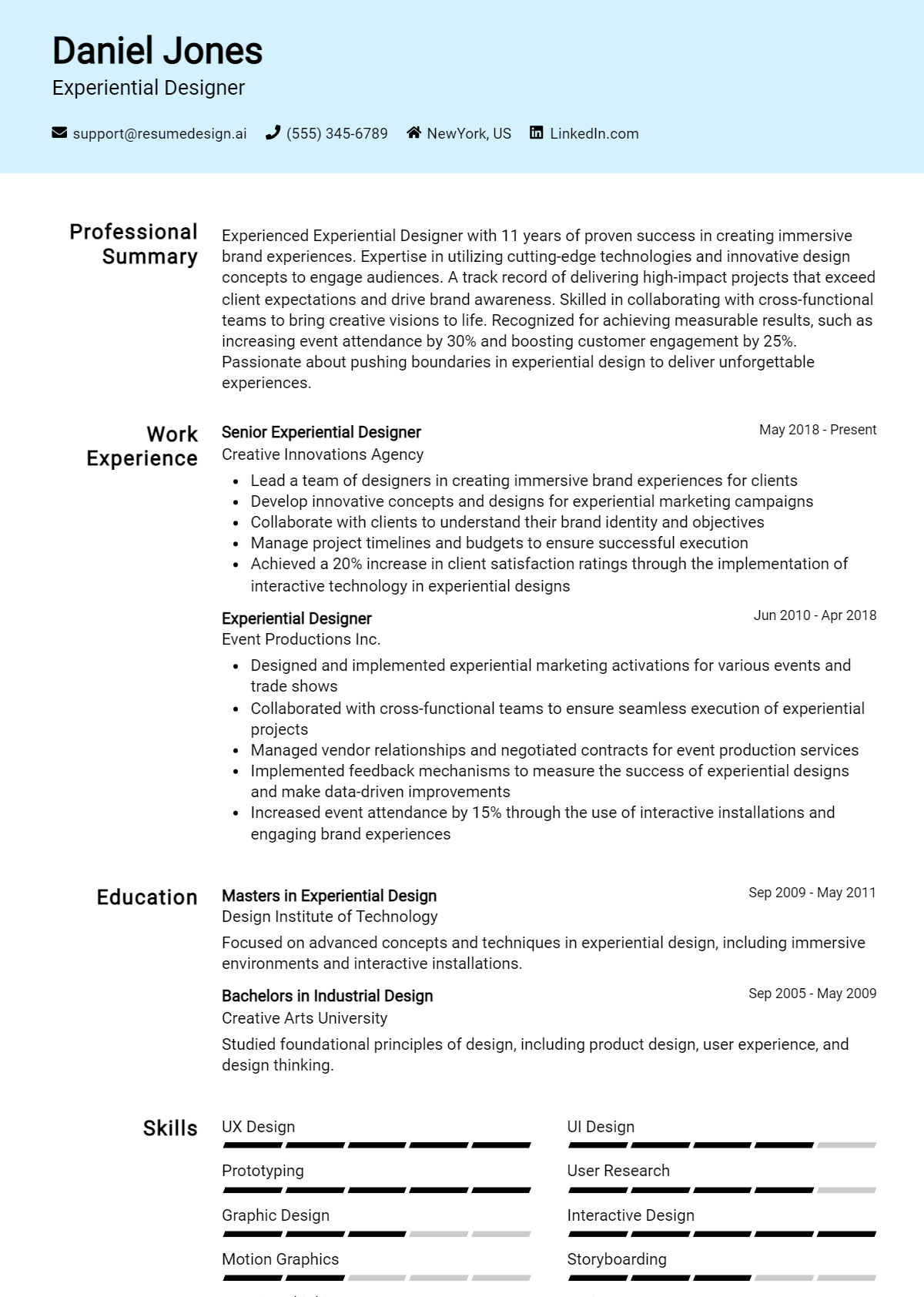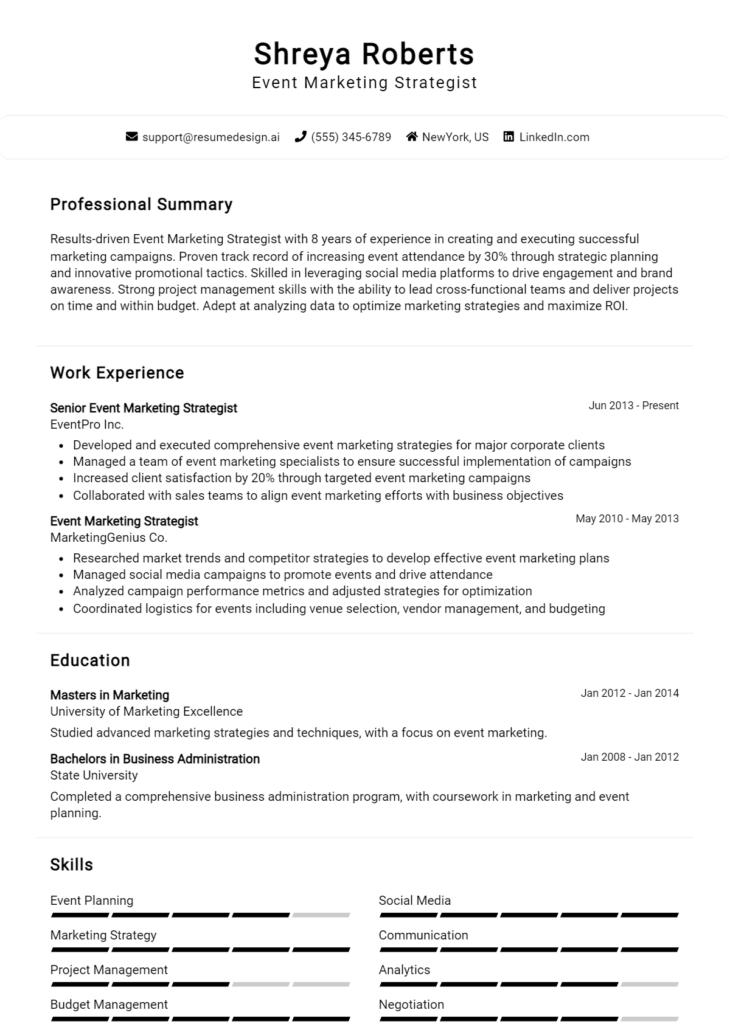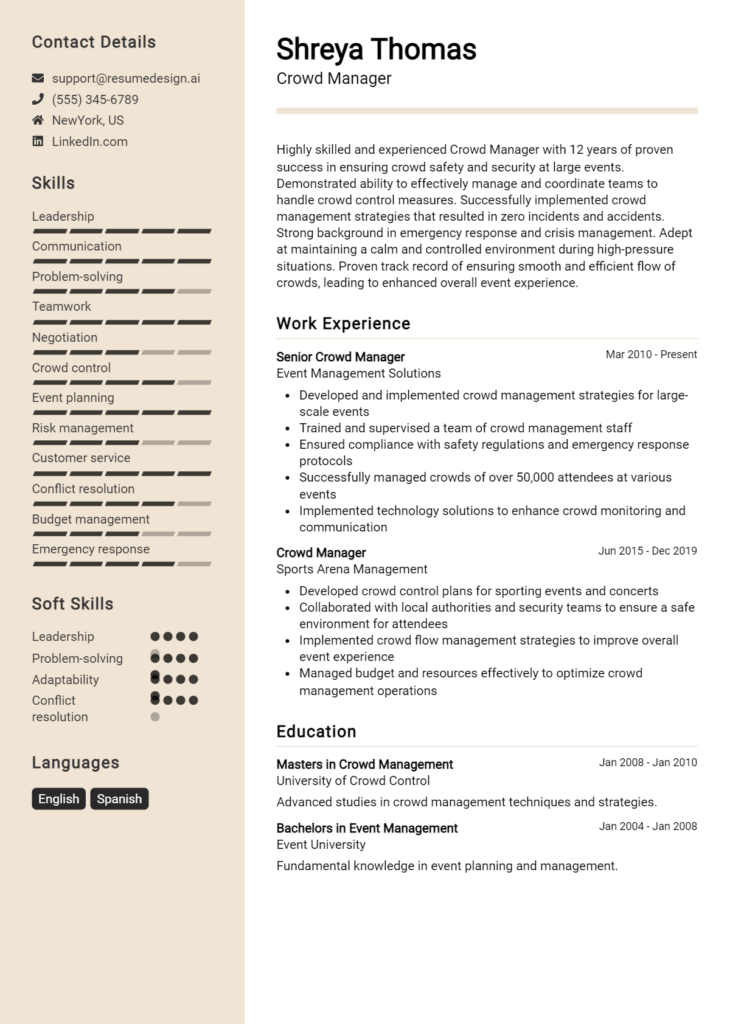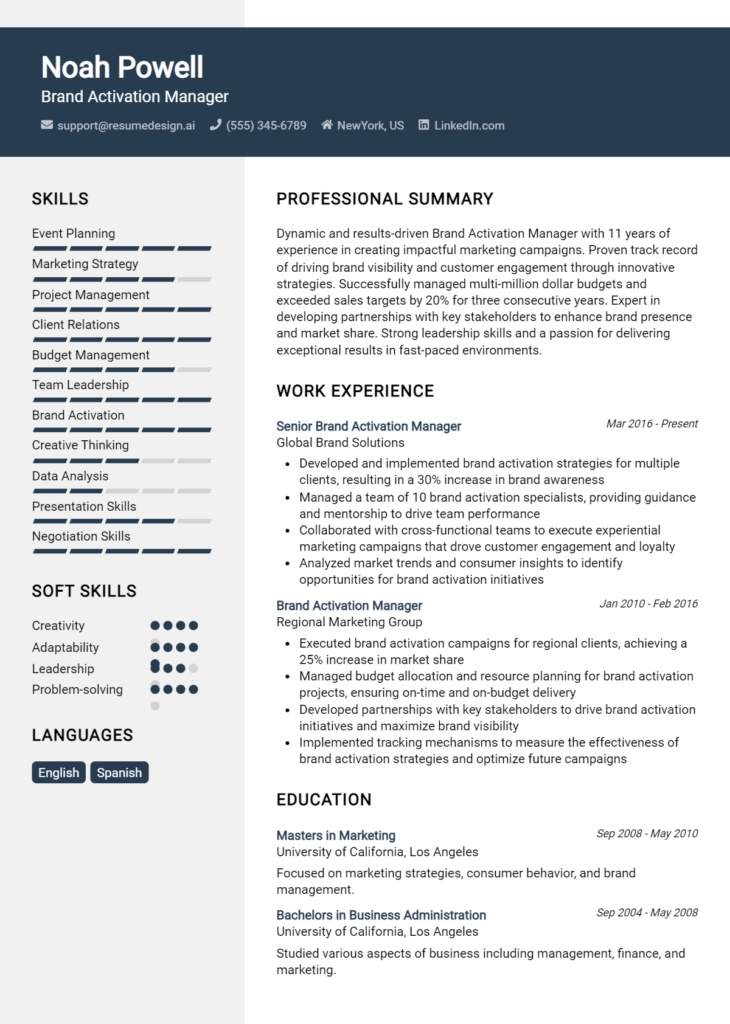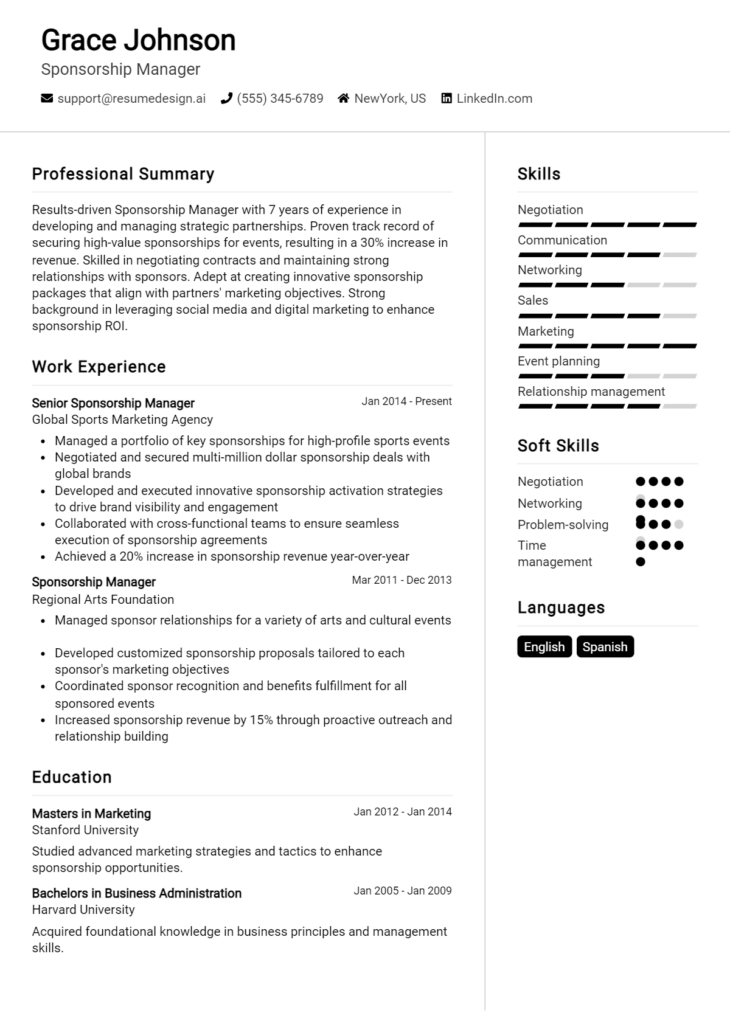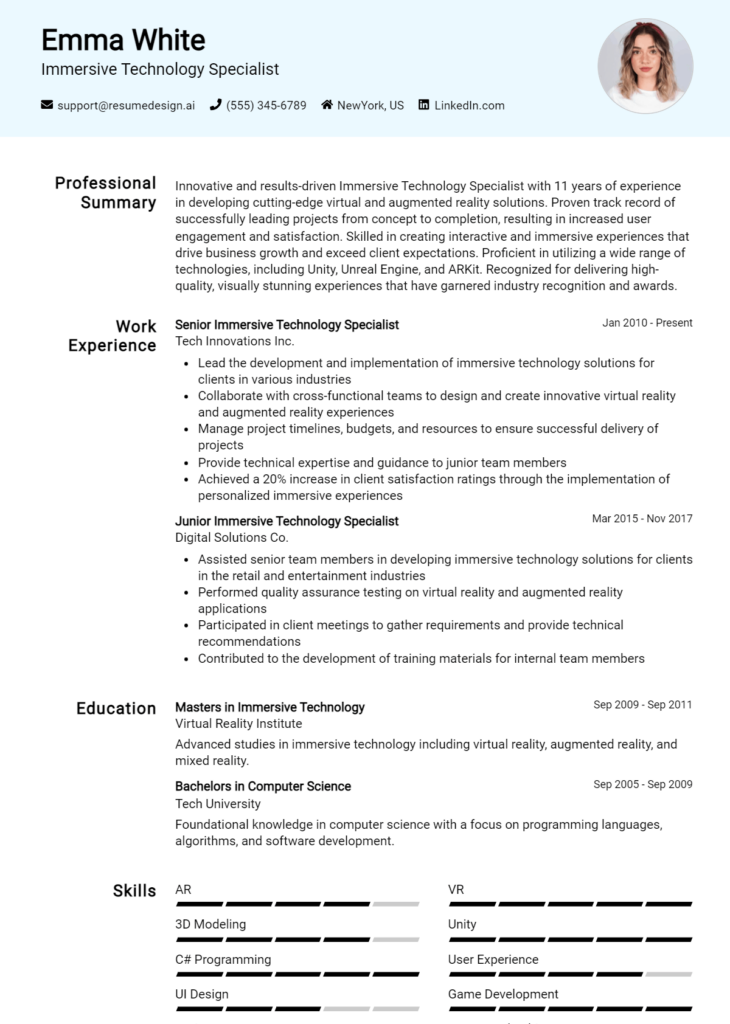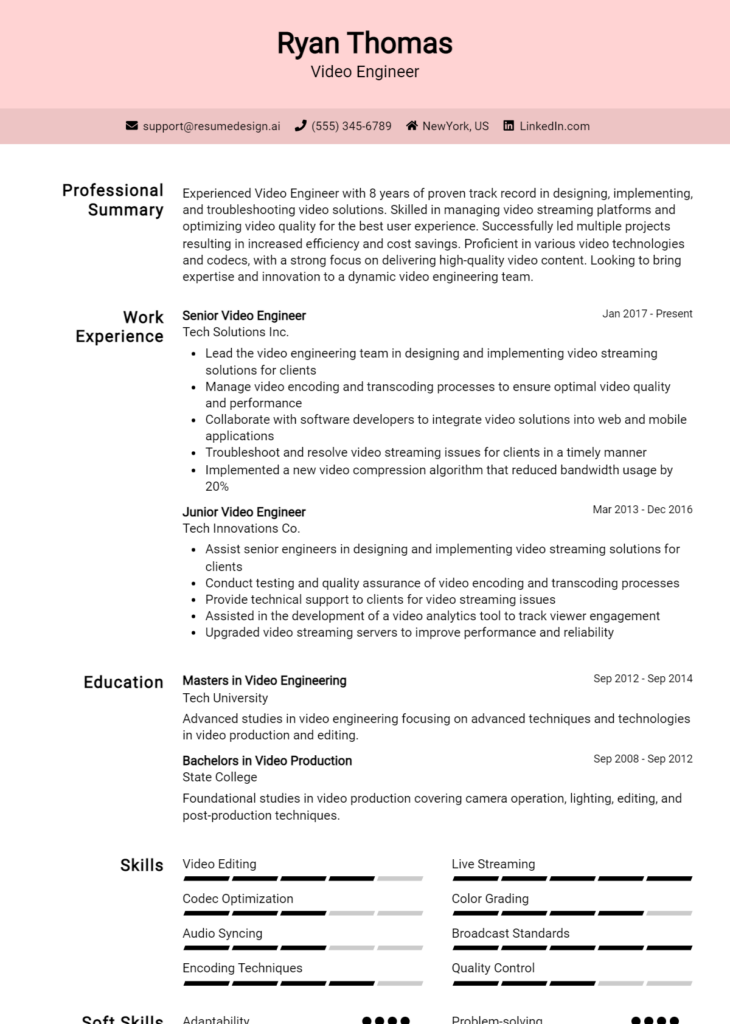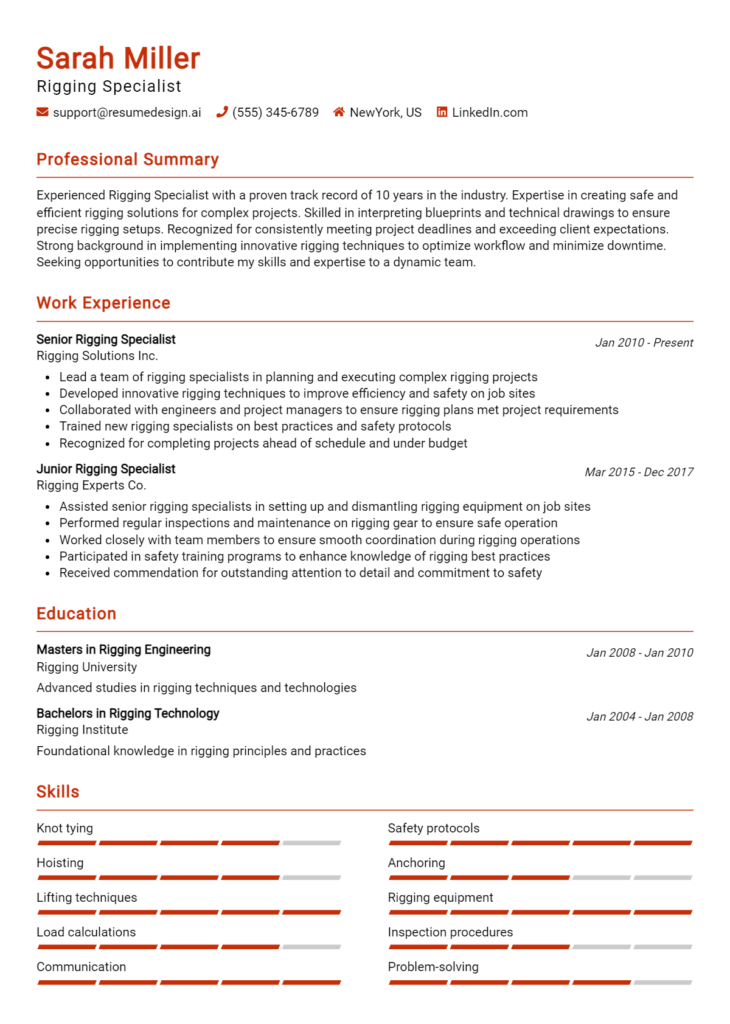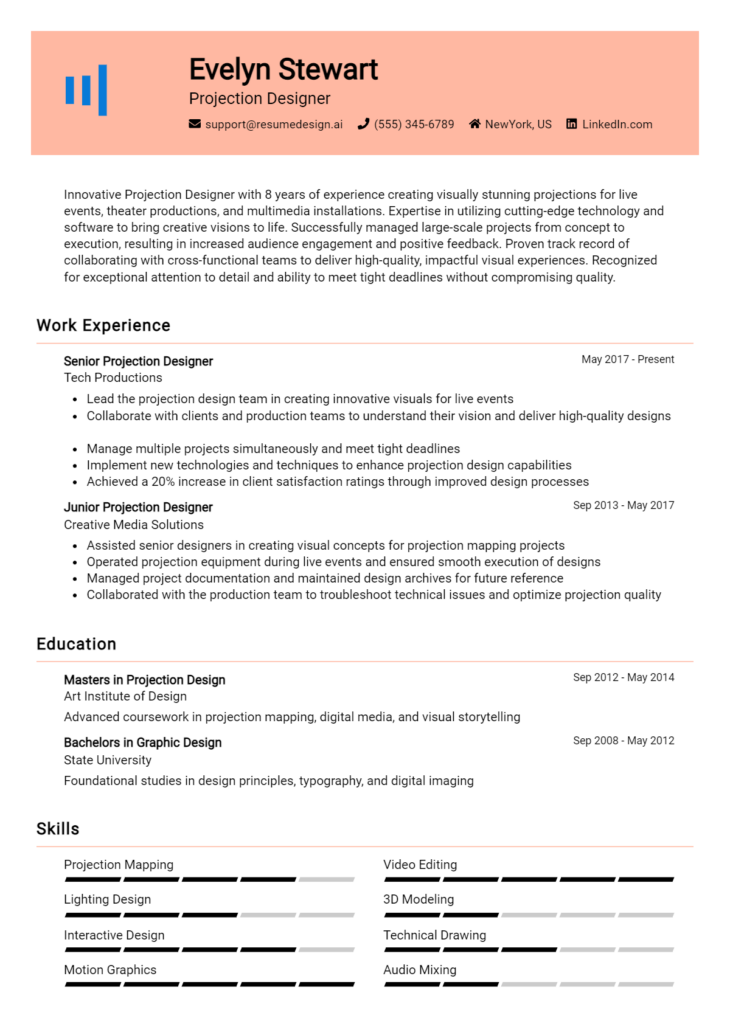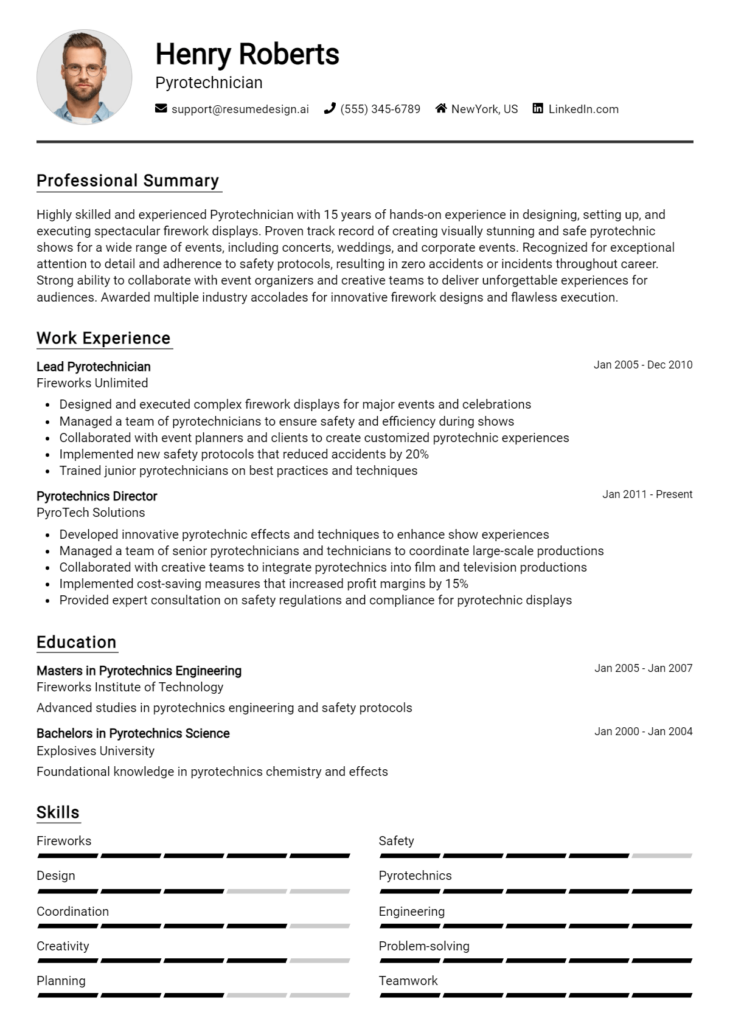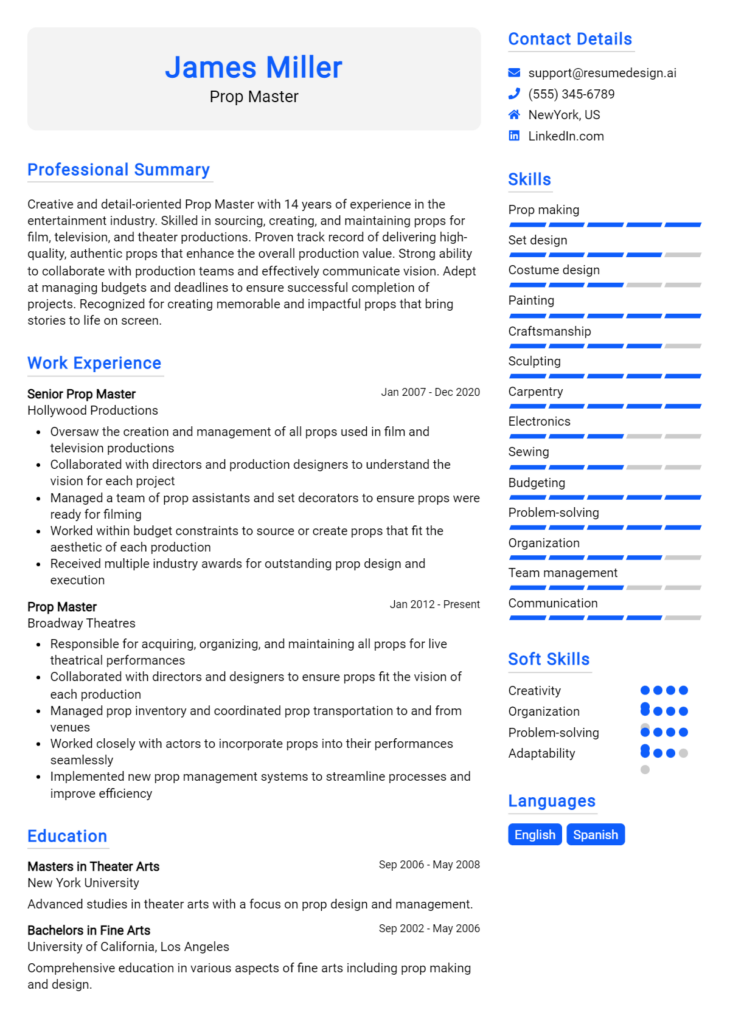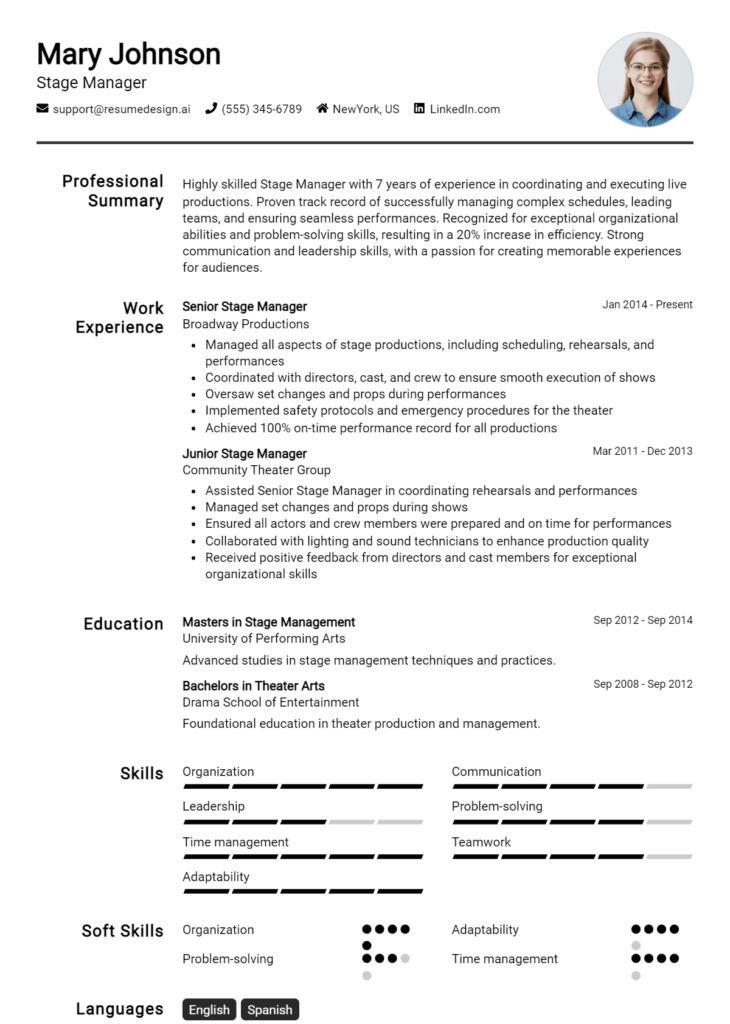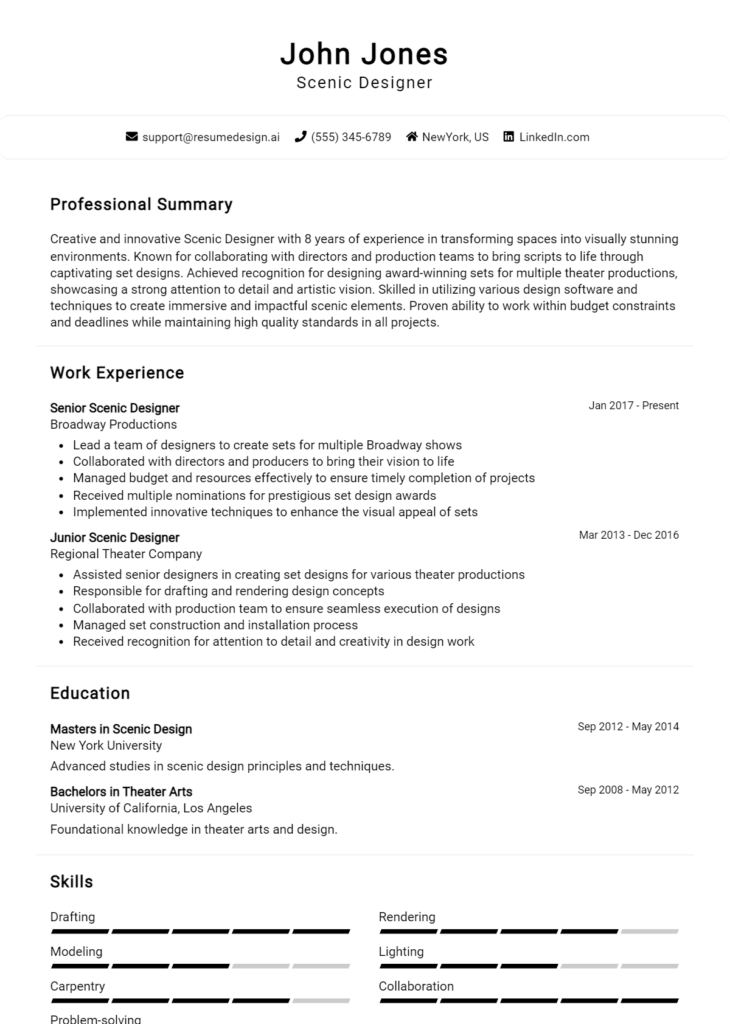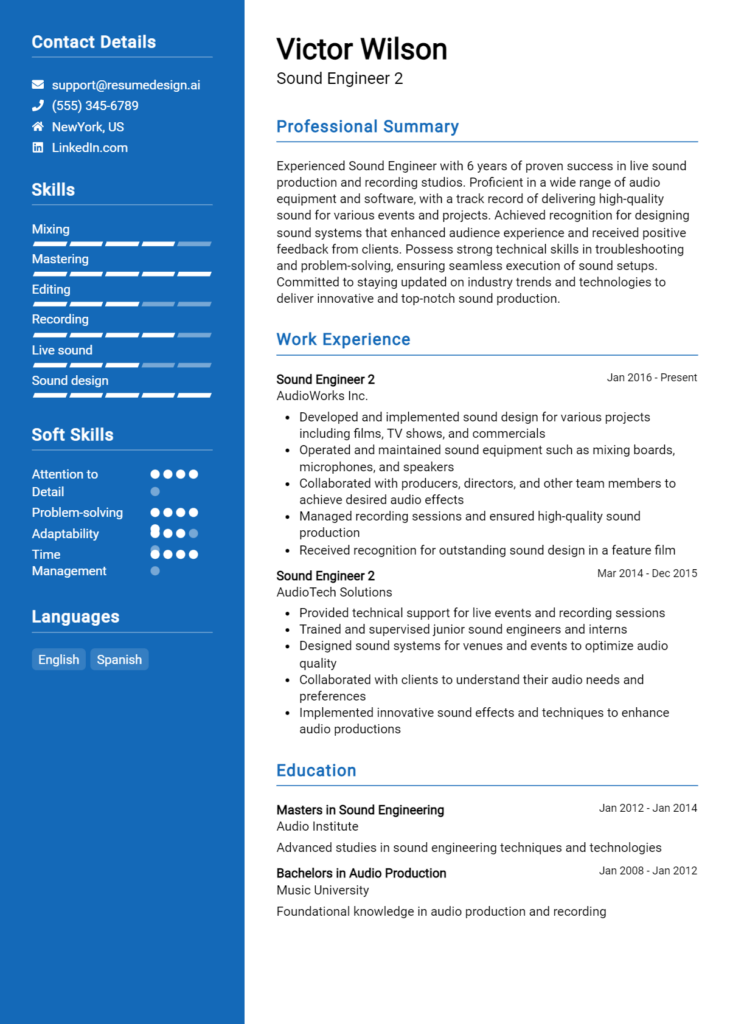Experiential Designer Core Responsibilities
An Experiential Designer plays a crucial role in creating immersive experiences that engage audiences, requiring a blend of technical, operational, and problem-solving skills. This professional collaborates across departments, including marketing, engineering, and creative teams, to ensure cohesive project execution. Key responsibilities include conceptualizing innovative designs, overseeing implementation, and evaluating user feedback. Mastery of design software and strong communication skills are essential. A well-structured resume can effectively highlight these qualifications, showcasing the designer's impact on the organization’s goals.
Common Responsibilities Listed on Experiential Designer Resume
- Develop and prototype immersive experiences across various platforms.
- Collaborate with cross-functional teams to align project objectives.
- Conduct user research and analyze feedback to improve designs.
- Create detailed design specifications and documentation.
- Manage project timelines and ensure deliverables meet quality standards.
- Utilize design software to produce visual and interactive elements.
- Present concepts and ideas to stakeholders for approval.
- Stay updated on industry trends and emerging technologies.
- Facilitate workshops and brainstorming sessions to generate ideas.
- Implement and optimize user interface designs for various devices.
- Monitor project budgets and resource allocation effectively.
- Evaluate the effectiveness of experiences through analytics and metrics.
High-Level Resume Tips for Experiential Designer Professionals
In the competitive field of experiential design, a well-crafted resume serves as your first opportunity to make a lasting impression on potential employers. It’s essential for your resume to not only showcase your skills and achievements but also to embody your creativity and understanding of the experiential design landscape. A strong resume can differentiate you from other candidates, highlighting your unique approach to creating immersive experiences that engage audiences. This guide will provide practical and actionable resume tips specifically tailored for experiential designer professionals, ensuring that your application stands out in a crowded market.
Top Resume Tips for Experiential Designer Professionals
- Tailor your resume to the job description by incorporating relevant keywords and phrases from the listing.
- Showcase your relevant experience by providing detailed descriptions of past projects, including your role and contributions.
- Quantify your achievements, such as the number of events designed, audience engagement metrics, or budget management success.
- Highlight industry-specific skills, such as proficiency in design software, project management tools, and event marketing strategies.
- Include a portfolio link to showcase your work visually, demonstrating your design capabilities and creativity.
- Utilize a clean and professional layout that reflects your design sensibility while ensuring easy readability.
- Incorporate testimonials or endorsements from previous clients or employers to add credibility to your experience.
- Keep your resume concise—ideally one page—focusing on the most relevant and impactful information.
- Update your resume regularly to reflect new skills, projects, and experiences in the evolving field of experiential design.
- Consider including a short personal statement or objective that clearly articulates your design philosophy and career goals.
By implementing these tips, you can significantly enhance your resume and increase your chances of landing a job in the experiential designer field. A polished resume that effectively communicates your unique qualifications and creative vision will not only attract the attention of potential employers but also set you on the path to a successful career in experiential design.
Why Resume Headlines & Titles are Important for Experiential Designer
In the competitive field of experiential design, where creativity and innovation are paramount, a well-crafted resume headline or title serves as the first impression for hiring managers. A strong headline can immediately grab attention, succinctly summarizing a candidate's key qualifications and expertise in just a few impactful words. This concise phrase should reflect the specific role being applied for, ensuring it is relevant and tailored to the job. By doing so, it not only highlights the applicant's strengths but also sets the tone for the rest of the resume, making it easier for recruiters to see the candidate's potential at a glance.
Best Practices for Crafting Resume Headlines for Experiential Designer
- Keep it concise: Aim for no more than 10-12 words.
- Be role-specific: Include keywords related to experiential design.
- Highlight key strengths: Focus on skills, achievements, or unique experiences.
- Use action-oriented language: Start with strong verbs to convey impact.
- Tailor to the job description: Align your headline with the specific role requirements.
- Avoid jargon: Use clear language to ensure understanding.
- Incorporate measurable outcomes: If possible, quantify achievements.
- Showcase creativity: Use innovative phrasing that reflects your design style.
Example Resume Headlines for Experiential Designer
Strong Resume Headlines
"Innovative Experiential Designer with 5+ Years in Immersive Brand Activation"
“Award-Winning Designer Specializing in Interactive Installations and User Engagement”
“Creative Strategist with Proven Track Record in Experiential Marketing Campaigns”
Weak Resume Headlines
“Designer Looking for Opportunities”
“Experienced Professional”
The strong headlines are effective because they are specific, action-oriented, and tailored to the role, providing a clear insight into what the candidate brings to the table. They highlight relevant experience and skills that align with the job description, making it easy for hiring managers to see the candidate's fit for the position. In contrast, the weak headlines fail to impress due to their vagueness and lack of detail; they do not offer any insight into the candidate’s qualifications or unique strengths, making it difficult for recruiters to differentiate them from other applicants.
Writing an Exceptional Experiential Designer Resume Summary
A resume summary is a crucial component for an Experiential Designer, serving as the first impression a hiring manager will have of the candidate. A well-crafted summary quickly captures attention by succinctly highlighting key skills, relevant experience, and notable accomplishments that align with the job role. This brief yet impactful introduction not only showcases the candidate's qualifications but also signals to the employer that they possess the specific expertise needed for the position. It should be concise and tailored to the job description, ensuring that every word counts in making a compelling case for the candidate's fit within the organization.
Best Practices for Writing a Experiential Designer Resume Summary
- Quantify achievements: Use numbers and metrics to demonstrate the impact of your work.
- Focus on relevant skills: Highlight specific skills that are directly related to experiential design.
- Tailor for the job description: Customize your summary to reflect the requirements of the position you are applying for.
- Use action verbs: Start sentences with strong action verbs to convey a sense of momentum and impact.
- Keep it concise: Aim for 3-5 sentences that deliver maximum information in minimum words.
- Showcase unique value: Identify what sets you apart from other candidates and make it prominent in your summary.
- Incorporate industry keywords: Use terminology that resonates within the experiential design industry to enhance relevance.
- Proofread for clarity: Ensure there are no grammatical errors or vague phrases that could undermine your professionalism.
Example Experiential Designer Resume Summaries
Strong Resume Summaries
Innovative Experiential Designer with over 6 years of experience creating immersive brand experiences that drive engagement and increase sales by up to 30%. Proficient in leveraging cutting-edge technology and design principles to develop multi-sensory environments that resonate with audiences.
Results-driven designer with a proven track record of leading cross-functional teams to deliver high-impact events and installations. Spearheaded a project that enhanced user engagement by 50%, utilizing interactive elements and storytelling techniques to create memorable experiences.
Creative professional skilled in designing experiential marketing campaigns, with a focus on user experience and spatial design. Successfully launched a national tour that attracted over 100,000 participants, significantly elevating brand awareness and customer loyalty.
Weak Resume Summaries
I am an Experiential Designer looking for a job where I can use my skills. I have experience in design and events.
Creative individual interested in creating experiences. I have worked on various projects and like to design things.
The strong resume summaries stand out because they are specific, include quantifiable outcomes, and directly relate to the responsibilities of an Experiential Designer. They showcase the candidate’s unique contributions and measurable successes, which can catch the eye of hiring managers. In contrast, the weak summaries lack specificity, fail to demonstrate any real achievements, and read too generically, making it difficult for them to convey the candidate's true potential and relevance to the role.
Work Experience Section for Experiential Designer Resume
The work experience section of an Experiential Designer resume is crucial as it provides potential employers with insight into a candidate's technical skills, project management abilities, and capacity to deliver high-quality results. This section serves as a platform for candidates to illustrate their proficiency in creating engaging experiences, managing teams effectively, and producing tangible outcomes. By quantifying achievements and aligning their experience with industry standards, candidates can effectively demonstrate their value and impact within the field, making them more appealing to hiring managers.
Best Practices for Experiential Designer Work Experience
- Highlight specific technical skills relevant to experiential design, such as proficiency in design software and tools.
- Quantify achievements by including metrics that demonstrate the impact of your work (e.g., increased user engagement by 30%).
- Showcase leadership abilities by describing experiences where you managed projects or teams.
- Align your experiences with industry standards and trends to demonstrate relevance.
- Use action verbs to convey a sense of initiative and impact in your role.
- Incorporate collaborative efforts and highlight partnerships with other departments or stakeholders.
- Tailor each experience to reflect the requirements of the job you are applying for.
- Provide context for your projects to help employers understand the challenges faced and solutions implemented.
Example Work Experiences for Experiential Designer
Strong Experiences
- Led a cross-functional team of 10 designers and developers to create an immersive brand experience that increased customer engagement by 40% at the annual trade show.
- Designed and executed an interactive installation that generated over 1,000 social media shares, directly contributing to a 25% increase in brand awareness.
- Managed a $200,000 budget for a high-profile experiential marketing campaign, delivering the project 10% under budget and achieving a 15% uplift in sales during the campaign period.
- Collaborated with marketing and sales teams to develop a user-centered design strategy that improved the customer journey, resulting in a 50% decrease in customer complaints.
Weak Experiences
- Worked on various projects related to experiential design.
- Assisted team members with design tasks as needed.
- Participated in meetings to discuss project progress.
- Contributed ideas for design improvements.
The examples listed above illustrate the differences between strong and weak experiences in an Experiential Designer's resume. Strong experiences are characterized by specific achievements, quantifiable outcomes, and a clear demonstration of leadership and collaboration. They provide concrete evidence of a candidate's skills and impact, making them compelling to employers. In contrast, weak experiences are vague and lack detail, failing to convey the candidate's contributions or relevance to the role, which diminishes their potential appeal to hiring managers.
Education and Certifications Section for Experiential Designer Resume
The education and certifications section of an Experiential Designer resume plays a pivotal role in showcasing a candidate's academic background and their commitment to ongoing professional development. This section not only reflects the educational achievements and specialized training relevant to the field but also emphasizes the candidate's dedication to staying current with industry standards and trends. By including relevant coursework, industry-recognized certifications, and any specialized training, candidates can significantly enhance their credibility and demonstrate their alignment with the job requirements, making them more attractive to potential employers.
Best Practices for Experiential Designer Education and Certifications
- Prioritize relevant degrees and certifications that align with experiential design and related fields.
- Include coursework that demonstrates your knowledge of design principles, user experience, or interactive technologies.
- Highlight industry-recognized certifications such as Certified Experience Designer (CXD) or similar credentials.
- Keep the section organized and easy to read, using bullet points for clarity.
- Be specific about the institutions from which you earned your degrees and certifications.
- Update your education section regularly to reflect any additional training or certifications.
- Consider including online courses from reputable platforms that are relevant to experiential design.
- Use distinct formatting to make this section stand out, such as bolding the degree names or certification titles.
Example Education and Certifications for Experiential Designer
Strong Examples
- Bachelor of Arts in Graphic Design, University of Arts, 2020
- Certified Experience Designer (CXD), Experience Design Institute, 2022
- User Experience Design Specialization, Coursera, 2021
- Masterclass in Interactive Design, Interaction Design Foundation, 2023
Weak Examples
- Associate Degree in Business Administration, Community College, 2015
- Basic Photoshop Course, Local Community Center, 2019
- Certificate in General Studies, Online University, 2018
- High School Diploma, High School, 2010
The strong examples are considered effective because they directly relate to the skills and knowledge required for an Experiential Designer, showcasing relevant education and specialized credentials that demonstrate expertise in the field. In contrast, the weak examples are less impactful as they include qualifications that do not align with the experiential design role, either due to their general nature or because they lack relevance to the specific skills and competencies needed in the industry.
Top Skills & Keywords for Experiential Designer Resume
As an Experiential Designer, showcasing the right skills on your resume is crucial for standing out in a competitive job market. Employers look for candidates who not only possess technical expertise but also demonstrate creativity, communication, and problem-solving abilities. A well-crafted resume that highlights both hard and soft skills can effectively communicate your unique qualifications and experiences, significantly increasing your chances of landing your dream job. For those looking to enhance their resumes, it’s essential to consider the key skills relevant to the role of an Experiential Designer.
Top Hard & Soft Skills for Experiential Designer
Soft Skills
- Creativity and Innovation
- Communication Skills
- Team Collaboration
- Problem Solving
- Adaptability
- Time Management
- Empathy and User-Centered Thinking
- Attention to Detail
- Critical Thinking
- Project Management
Hard Skills
- Experience with Design Software (e.g., Adobe Creative Suite)
- 3D Modeling and Visualization
- Prototyping Techniques
- User Experience (UX) Design
- Graphic Design
- Motion Graphics
- Event Planning and Coordination
- Knowledge of Marketing Principles
- Familiarity with Virtual/Augmented Reality
- Data Analysis and Interpretation
By emphasizing both sets of skills, you can create a comprehensive picture of your expertise that appeals to potential employers while demonstrating your ability to deliver memorable experiences through design. Don't forget to showcase your relevant work experience to further bolster your resume.
Stand Out with a Winning Experiential Designer Cover Letter
Dear [Hiring Manager's Name],
I am excited to apply for the Experiential Designer position at [Company Name] as advertised on [Where You Found the Job Posting]. With a robust background in creating immersive and engaging experiences, I am confident in my ability to contribute to your team's innovative projects and help elevate the brand’s presence in the marketplace. My experience in both digital and physical environments, coupled with a passion for storytelling through design, aligns well with the vision of [Company Name].
In my previous role at [Previous Company Name], I successfully led the design and execution of a multi-sensory pop-up experience that increased brand engagement by 35%. My ability to collaborate with cross-functional teams—including marketing, technology, and operations—allowed us to create a cohesive vision that resonated with our target audience. I thrive in dynamic environments where creative problem-solving and innovative thinking are essential, and I am eager to bring that energy to [Company Name] as part of your team.
I am particularly impressed by [mention a specific project or value of the company], and I believe my skills in user experience design, along with my hands-on approach to prototyping and testing, can help push the boundaries of what experiential design can achieve. I am adept at leveraging data-driven insights to inform design decisions while also ensuring that the human experience remains at the forefront of every project.
Thank you for considering my application. I look forward to the opportunity to discuss how my background and skills can contribute to the exciting work at [Company Name]. I am eager to bring my creativity and dedication to your team and help craft unforgettable experiences for your audience.
Sincerely,
[Your Name]
[Your Contact Information]
[Your LinkedIn Profile or Portfolio Link]
Common Mistakes to Avoid in a Experiential Designer Resume
When crafting a resume as an Experiential Designer, it's crucial to highlight your unique skills and experiences effectively. However, many candidates make common mistakes that can dilute their impact and hinder their chances of landing an interview. Avoiding these pitfalls will help ensure that your resume stands out in a competitive field. Here are some frequent errors to watch out for:
Vague Job Descriptions: Failing to provide specific details about your previous roles can leave hiring managers unclear about your actual contributions and achievements. Use concrete examples and metrics where possible.
Ignoring the Target Audience: Not tailoring your resume to the specific company or role can make it seem generic. Research the company’s projects and values, and align your experience accordingly.
Overloading with Technical Jargon: While industry terminology is important, excessive jargon can confuse readers. Balance the use of technical language with clear, accessible descriptions of your work.
Neglecting Visual Appeal: As an Experiential Designer, your resume should reflect your design sensibility. A cluttered or unattractive layout can detract from your qualifications. Aim for a clean, visually appealing format.
Lack of Quantifiable Achievements: Simply listing responsibilities rather than accomplishments can weaken your case. Use numbers and specific outcomes to illustrate your impact, such as "Increased engagement by 30% through interactive installations."
Not Highlighting Relevant Skills: Focusing too much on past positions without emphasizing relevant skills can make your resume less compelling. Ensure to showcase key skills that align with experiential design, such as UX/UI design, project management, and creative problem solving.
Forgetting Soft Skills: Experiential design often requires collaboration and communication. Neglecting to showcase your soft skills can give a skewed impression of your capabilities. Include examples of teamwork, leadership, or client interactions.
Typos and Grammatical Errors: Simple mistakes can undermine your professionalism. Always proofread your resume multiple times and consider having someone else review it to catch any errors that may have slipped through.
Conclusion
As an Experiential Designer, your role involves creating engaging and immersive experiences that resonate with audiences across various platforms. Throughout this article, we've explored the essential skills and qualifications necessary for success in this field, including a strong foundation in design principles, user experience, and storytelling. We've also highlighted the importance of collaboration and adaptability in a fast-paced environment, where innovation is key to standing out.
In summary, to thrive as an Experiential Designer, you should focus on honing your technical skills, understanding your audience's needs, and continuously seeking inspiration from diverse sources. Additionally, having a strong portfolio that showcases your projects can significantly enhance your chances of landing your dream job.
Now is the perfect time to review your Experiential Designer resume and ensure it reflects your unique skills and experiences accurately. To assist you in this process, consider utilizing helpful resources like resume templates, a resume builder, and resume examples to create a standout application. Don't forget to craft a compelling cover letter using our cover letter templates. Take action today and elevate your resume to capture the attention of potential employers!

